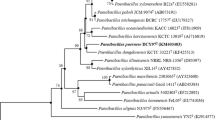Abstract
A strain with urethanase activity was isolated from mouse gastrointestine. By combination of morphological characterization of the colony, hyphae, and spore and the sequence analysis of its rDNA ITS, the strain was determined as Penicillium variabile and named as P. variabile JN-A525. The enzymatic properties of urethanase from P. variabile JN-A525 were further studied. The optimum temperature and pH value of urethanase are of 50 °C and 6.0, respectively. The enzyme maintains stability when the temperature is below 50 °C and the pH is in the range of 7.0–10.0. The enzyme also exhibits ethanol tolerance. It can remove ethyl carbamate from Chinese rice wine without the change of flavor substances in the wine.









Similar content being viewed by others
References
Gao, H. (1991). Analytical chemistry. Beijing: Science Press.
Lachenmeier, D. W., Przybylski, M. C., & Rehm, J. (2012). Comparative risk assessment of carcinogens in alcoholic beverages using the margin of exposure approach. International Journal of Cancer, 131, E995–E1003.
Ough, C. S. (1976). Ethyl carbamate in fermented beverages and foods. I. Naturally occurring ethyl carbamate. Journal of Agriculture and Food Chemistry, 24, 323–328.
Zhao, C. J., & Kobashi, K. (1994). Urethanase in rat tissues. Biological and Pharmaceutical Bulletin, 17, 773–778.
Chun, J. Z., Lisa, I., & Kyoichi, K. (1991). Urethanase of Bacillus licheniformis sp. isolated from mouse gastrointestine. Chemical and Pharmaceutical Bulletin, 39, 3303–3306.
Kyoichi, K., Sachiko, T., & Tatsuo, S. (1989). Urethane-hydrolyzing enzyme from Citrobacter sp. Chemical and Pharmaceutical Bulletin, 38, 1326–1328.
Weber, J. V., & Sharypov, V. I. (2008). Ethyl carbamate in foods and beverages: a review. Environmental Chemistry Letters, 7, 233–247.
Gao, N. F., & Bao, J. H. (2006). Research advancement of ethyl carbamate. China Brewing, 162, 1–4 (In Chinese).
Lachenmeier, D. W., Schehl, B., & Kuballa, T. (2005). Retrospective trends and current status of ethyl carbamate in German stone-fruit spirits. Food Additives and Contaminants, 22, 397–405.
Canas, B. J., Joe, F. L., & Diachenko, G. W. (1994). Determination of ethyl carbamate in alcoholic beverages and soy sauce by chromatography with mass selective detection collaborative study. Journal of AOAC International, 77, 1530–1536.
Summary and conclusions of the sixty-fourth meeting of the Joint FAO/WHO Expert Committee on Food Additives (JECFA), Rome, 8–17 February 2005. ftp://ftp.fao.org/es/esn/jecfa/jecfa64_summary.pdf
Schehl, B., Senn, T., Lachenmeier, D. W., Rodicio, R., & Heinisch, J. J. (2007). Contribution of the fermenting yeast strain to ethyl carbamate generation in stone fruit spirits. Applied Microbiology and Biotechnology, 74, 843–850.
Yang, L. Q., Wang, S. H., & Tian, Y. P. (2010). Purification, properties, and application of a novel acid urease from Enterobacter sp. Applied Biochemistry and Biotechnology, 8, 8159–8160.
Kobashi, K., & Takabe, S. (1988). Removal of urea from alcoholic beverages with an acid urease. Journal of Applied Toxicology, l34, 73–74.
Zhao, C. J., & Kobashi, K. (1994). Purification and characterization of iron containing urethanase from Bacillus licheniformis. Chemical and Pharmaceutical Bulletin, 17, 773–778.
Mohapatra, B. R., & Bapuji, M. (1997). Characterization of urethanase from Micrococcus species associated with the marine sponge (Spirasfrella species). Letters in Applied Microbiology, 25, 393–396.
Weatherburn, M. W. (1967). Phenol-hypochlorite reaction for determination of ammonia. Analytical Chemistry, 39, 971–974.
Liu, J., Xv, Y., & Chen, J. (2012). Rapid determination of ethyl carbamate in Chinese rice wine by HS-SPME and GC-MS. Science and Technology of Food Industry, 4, 60–69 (In Chinese).
Luo, T., Fan, W. L., & Xu, Y. (2008). Characterization of volatile and semi-volatile compounds in Chinese rice wines by headspace solid phase microextraction followed by gas chromatography–mass spectrometry. Journal of the Institute of Brewing, 114, 172–179.
Arminda, A., Beatriz, O., & Paulo, H. (2005). Determination of ethyl carbamate in alcoholic beverages: an interlaboratory study to compare HPLC-FLD with GC-MS methods. Analytical Biochemistry, 382, 498–503.
Acknowledgments
This work was supported by the Major State Basic Research Development Program of China (973 Program, 2012CB720802).
Author information
Authors and Affiliations
Corresponding author
Rights and permissions
About this article
Cite this article
Zhou, Nd., Gu, Xl. & Tian, Yp. Isolation and Characterization of Urethanase from Penicillium variabile and Its Application to Reduce Ethyl Carbamate Contamination in Chinese Rice Wine. Appl Biochem Biotechnol 170, 718–728 (2013). https://doi.org/10.1007/s12010-013-0178-2
Received:
Accepted:
Published:
Issue Date:
DOI: https://doi.org/10.1007/s12010-013-0178-2




